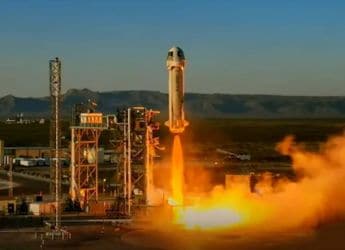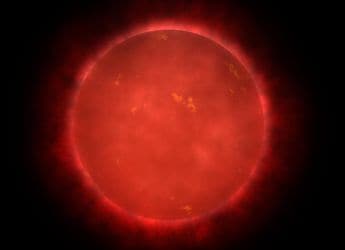- Home
- Science
- Science News
- How a Gigantic Collision in Space Triggered an Ice Age on Earth 466 Million Years Ago
How a Gigantic Collision in Space Triggered an Ice Age on Earth 466 Million Years Ago
Scientists on Wednesday said dust spawned by a gigantic collision in the asteroid belt between Mars and Jupiter 400 million years earlier triggered an ice age on Earth that ushered in a significant increase in marine biodiversity.
A giant asteroid collision between Mars and Jupiter that occurred 466 million years ago (illustration)
The cataclysmic asteroid impact off Mexico's coast that doomed the dinosaurs 66 million years ago was not the only time an astronomical event shaped the history of life on Earth.
Scientists on Wednesday said dust spawned by a gigantic collision in the asteroid belt between Mars and Jupiter 400 million years earlier triggered an ice age on Earth that ushered in a significant increase in marine biodiversity.
The event, occurring when life was concentrated in the seas and far before vertebrates first walked on land, set in motion evolutionary changes in invertebrates fundamental to marine ecosystems as they adapted to global cooling, they said.
The inner solar system was filled with enormous amounts of dust after an asteroid more than 90 miles (150 km) in diameter was struck by a smaller object perhaps 12 miles (20 km) wide, the researchers said. It was the solar system's largest-known breakup event in the past 2 billion years.
Solar radiation reaching Earth's surface was reduced for at least 2 million years by the dust in space and in the planet's atmosphere, said study co-author Philipp Heck, an associate curator at the Field Museum in Chicago.
Another cooling mechanism was that the iron-rich meteoritic dust fertilized large parts of the ocean surface leading to increased plankton productivity and drawdown of atmospheric carbon dioxide, added Birger Schmitz, a geology professor at Lund University in Sweden and lead author of the research published in the journal Science Advances.
"In the last few decades, researchers have begun to understand that evolution of life on Earth is dependent on astronomical events also," Schmitz said.
After noting the dinosaur-demise event caused by an asteroid perhaps 6 miles (10 km) wide, Schmitz added, "For the first time, scientists can now present another example of how an extraterrestrial event formed life on Earth."
The researchers found traces of dust in sedimentary rocks formed at the time containing special helium isotopes and rare minerals that revealed its extraterrestrial origin.
Invertebrate groups that experienced diversification included horseshoe crab-like trilobites, clams, clam-like brachiopods and a group called gastropods that included snails and slugs.
The cooling event unfolded gradually, enabling marine life during the Ordovician Period to adapt, unlike the sudden impact that erased the dinosaurs. Earth's climate changed from being tropical to semitropical worldwide to becoming divided into climate zones as it is today with frozen poles and tropical conditions at the equator.
© Thomson Reuters 2019
Get your daily dose of tech news, reviews, and insights, in under 80 characters on Gadgets 360 Turbo. Connect with fellow tech lovers on our Forum. Follow us on X, Facebook, WhatsApp, Threads and Google News for instant updates. Catch all the action on our YouTube channel.
Related Stories
- Samsung Galaxy Unpacked 2025
- ChatGPT
- Redmi Note 14 Pro+
- iPhone 16
- Apple Vision Pro
- Oneplus 12
- OnePlus Nord CE 3 Lite 5G
- iPhone 13
- Xiaomi 14 Pro
- Oppo Find N3
- Tecno Spark Go (2023)
- Realme V30
- Best Phones Under 25000
- Samsung Galaxy S24 Series
- Cryptocurrency
- iQoo 12
- Samsung Galaxy S24 Ultra
- Giottus
- Samsung Galaxy Z Flip 5
- Apple 'Scary Fast'
- Housefull 5
- GoPro Hero 12 Black Review
- Invincible Season 2
- JioGlass
- HD Ready TV
- Laptop Under 50000
- Smartwatch Under 10000
- Latest Mobile Phones
- Compare Phones
- Huawei Nova 15
- Huawei Nova 15 Pro
- Huawei Nova 15 Ultra
- OnePlus 15R
- Realme Narzo 90x 5G
- Realme Narzo 90 5G
- Vivo S50 Pro Mini
- Vivo S50
- Asus ProArt P16
- MacBook Pro 14-inch (M5, 2025)
- OnePlus Pad Go 2 (5G)
- Infinix Xpad Edge
- OnePlus Watch Lite
- Just Corseca Skywatch Pro
- Acerpure Nitro Z Series 100-inch QLED TV
- Samsung 43 Inch LED Ultra HD (4K) Smart TV (UA43UE81AFULXL)
- Asus ROG Ally
- Nintendo Switch Lite
- Haier 1.6 Ton 5 Star Inverter Split AC (HSU19G-MZAID5BN-INV)
- Haier 1.6 Ton 5 Star Inverter Split AC (HSU19G-MZAIM5BN-INV)







![[Partner Content] OPPO Find X9 Two Week Experience: Here's Why It Stands Out](https://www.gadgets360.com/static/mobile/images/spacer.png)









